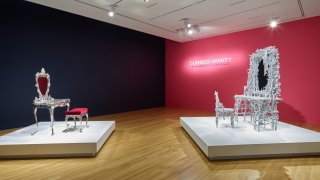
As a student at Booker T. Washington High School for the Performing and Visual Arts, Chris Schanck visited the Dallas Museum of Art on school trips. More than 25 years after graduating from Dallas’ arts magnet high school, Schanck is having his first museum solo exhibition and first museum commission at his hometown museum. Curbed Vanity: A Contemporary Foil by Chris Schanck is now on view in the Dallas Museum of Art’s Focus Gallery II through August 29.
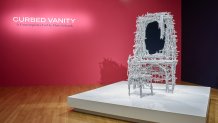
While introducing the exhibition, the Detroit-based designer reminisced about his childhood in Dallas and the important role the Dallas Museum of Art played in his creative development.
Schanck received a grant through the museum for college and when he needed a letter of recommendation, he showed one of the museum’s curators his work in the parking garage. “There are so many amazing, wonderful connections, a lot of hard work and a lot of amazing people I’ve met along the way here and I’m just super honored,” Schanck said.
Get DFW local news, weather forecasts and entertainment stories to your inbox. Sign up for NBC DFW newsletters.
Schanck collaborated with Sarah Schleuning, the museum’s Interim Chief Curator and The Margot B. Perot Senior Curator of Decorative Arts and Design to develop this exhibition. The museum served as an incubator for the creative endeavor. “The whole process from talking to sketching was almost a year on its own to get the concept and then another year or two to create it,” Schanck said.
The exhibition pairs the Gorham Manufacturing Company’s Martelé dressing set from the museum’s collection with Schanck’s contemporary interpretation. In the gallery, the two pieces face each other in a perpetual conversation across the years.
“One of the things we wanted to do with the installation is really have the two pieces in dialogue with each other and have the visitor come between them,” Schleuning said. “They beautifully reflect off each other. You can get some nice selfies.”
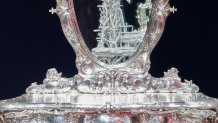
The Martelé dressing set was introduced at the 1900 Paris World’s Fair. More than 2,300 hours of skilled labor resulted in this opulent icon of the era. Comprised of high-quality solid silver, it is a grand example of the Gilded Age’s craftsmanship.
The Scene
Schanck’s dressing set is made of found objects, discovered in his Banglatown neighborhood in Detroit. It is a tribute to the craftsmanship of the urban landscape.
“What I find poetic about his work is that he takes things that have been discarded and finds a renewed hope for them and possibility, and he combines them and makes a new magical piece,” Schleuning said.
A closer examination of Schanck’s dressing set reveals pieces of chain link fence, pipes, twigs, and draped fabric. Every angle exposes a secret. “I want to make sure you walk around the back of this. This is a piece not meant to be against a wall,” Schleuning said.
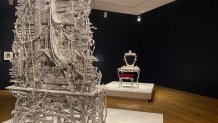
Schanck uses his “Alufoil” technique to cover the assembled pieces with a glimmering silver veneer. His interest in aluminum stems from his Dallas upbringing. His father worked in an aluminum factory in North Dallas and Schanck spent time shadowing him.
His mother’s crafting skills showed him the aesthetic potential of the material. “When we were children, she would cover all the Christmas presents in aluminum foil and they would just sparkle. It was the most beautiful thing I had seen,” Schanck said.
When Schanck began using aluminum as a material for artwork, he purchased foil in grocery stores. He learned to get the effect he wanted, he needed to find higher-quality, thinner foil.
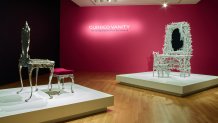
The exhibition features a pictorial explanation of how Schanck and his team created the piece and the elaborate technique he employs to make the work sparkle like his childhood Christmas presents. “It’s a type of work I’ve wanted to make for nearly ten years,” Schanck said.
Learn more: https://dma.org/



